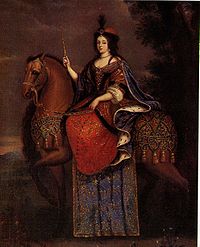- Marie Casimire Louise de La Grange d'Arquien
-
Marie Casimire Queen consort of Poland
Grand Duchess consort of LithuaniaTenure 1676–1696 Coronation 2 February 1676 Spouse John Zamoyski
John III SobieskiIssue Jakub Ludwik Sobieski
Teresa Teofila Sobieska
Adelaide Luise Sobieska
La Mannone Sobieska
Teresa Kunegunda Sobieska
Aleksander Benedykt Sobieski
Konstanty Władysław Sobieski
Jan SobieskiFather Henri de la Grange d'Arquien Mother Françoise de la Châtre Born June 28, 1641 Died January 1, 1716 (aged 74) Signature Marie Casimire Louise de La Grange d'Arquien, in Polish: Maria Kazimiera, known also by the diminutive form "Marysieńka" (June 28, 1641, Nevers – January 1, 1716, Blois) was consort to King John III Sobieski, from 1674 to 1696.
Contents
Biography
She came to Poland at the age of five years as a lady in waiting to Marie Louise Gonzaga, the French-born Queen of Poland from 1645 to 1672, wife and consort to two Polish kings — Władysław IV Vasa and later his brother (who succeeded him) John II Casimir Vasa. At the court she met John Sobieski, who arrived there in 1656, but she was first married to Jan "Sobiepan" Zamoyski in 1658. Zamoyski, however, died in 1665 and the widowed Marie Casimire eventually married Sobieski on the 14 July the same year. The couple had fourteen children together, but only four of them survived until adult age — Jakub, Aleksander, Konstanty and Teresa (who later became Kurfürstin of Bavaria and mother to Emperor Karl VII).
John Sobieski was elected King of Poland in 1672, not without the influence of his wife. As the Queen of Poland, Marie Casimire supported the proposed Polish–French alliance, while at the same time striving to gain privileges for her family from the French king Louis XIV.
The Royal couple became famous for their love letters, most of which were written from 1665 to 1683, when they were parted either due to John III Sobieski's military engagements or her travels to Paris. The letters give insight not only into the authentic feelings of the loving couple, but also their reflections on contemporary issues and difficulties, as well as down-to-earth matters concerning the royal household and little day-to-day decisions made by the monarch, who often consulted his wife about them.[1] Published long after the death of both of them, they can be credited with popularizing the King's way of addressing the Queen by the very diminutive form of her first name — "Marysieńka". She is widely remembered and referred to in Poland that way.
Ancestors
Charles de La Grange d' Arquian of Montigny Antoine de La Grange d'Arquien Louise de Rochechouart of Boiteaux Henri Albert de La Grange d'Arquien Louis d' Ancienville of Révillon Anne d'Ancienville Françoise de La Platière of Epoisses Marie Casimire Louise de la Grange d'Arquien Jean de La Châtre of Bruillebault Baptiste de La Châtre of Bruillebault Madeleine de Cluys Françoise de La Châtre Bonaventure Lamy of Chasteauguillon Gabrielle Lamy Louise de La Marche[2] Gallery
References
- ^ (English) "Astrea and Celadon, or the letters of Jan Sobieski and Marysieńka". wilanow-palac.art.pl. http://www.wilanow-palac.pl/astrea_and_celadon_or_the_letters_of_jan_sobieski_and_marysienka.html. Retrieved 2011-11-03.
- ^ Geneall.fr
- This article incorporates information from the revision as of 17 August 2006 of the equivalent article on the Polish Wikipedia.
External Links
Maria Kazimierza de la Grange d'Arquien at the Wilanow Palace Museum
See also
- Marywil and Marymont, two places named after Marysieńka.
- Wilanów Palace
Marie Casimire Louise de La Grange d'ArquienBorn: 28 June 1641 Died: 1 January 1716Royal titles Preceded by
Eleonora Maria of AustriaQueen consort of Poland
Grand Duchess consort of Lithuania
1676–1696Succeeded by
Christiane Eberhardine of Brandenburg-BayreuthCategories:- Polish queens consort
- Grand Duchesses of Lithuania
- Prussian royal consorts
- French nobility
- French people of Polish descent
- 1641 births
- 1716 deaths
- Recipients of the Golden Rose
- Polish women in politics
- Burials at Archcathedral Basilica of Sts. Stanisław and Vaclav, Kraków
Wikimedia Foundation. 2010.






